A Jewel on the Lakefront
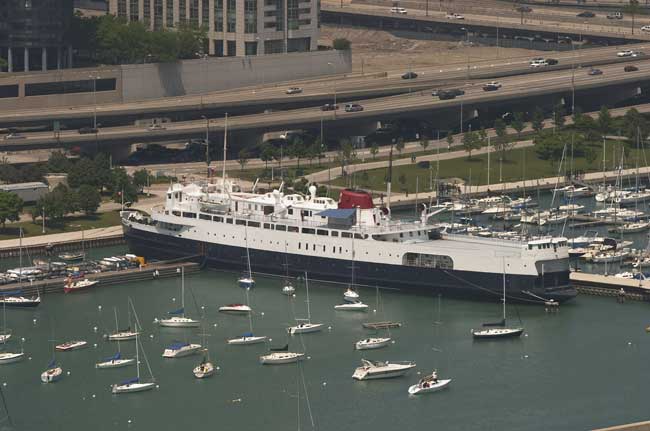 |
What is that big ship and where does it go? Are the most frequent questions
heard from those who see the "big blue boat" tied up at the head or north end of
Chicago's Monroe Harbor for the first time. The answer to this question is that
the boat is Columbia Yacht Club and it doesn't go anywhere. This landmark vessel
on the Chicago lakefront is the "Abegweit" or "Abby", the most recent in a
series of ships that have been the home to Columbia Yacht Club.
Columbia Yacht Club's Unique History
Columbia Yacht Club boasts a history rich in tradition and almost as old as
Chicago itself. Plans were put together for the club in 1891, by five sailors
who wanted to establish a new downtown yacht club. In 1892, a charter was
granted this group by the state and a site selected at the foot of Randolph
Street, where it still resides after 113 years.
Columbia has the unique distinction of having always been a floating yacht club.
The original clubship was a hand built shack on a floating barge located at the
foot of Randolph Street near its current location. The ideal location brought
many new members, so "the shack" was soon replaced by a 2-story building, still
afloat, to accommodate the new members.
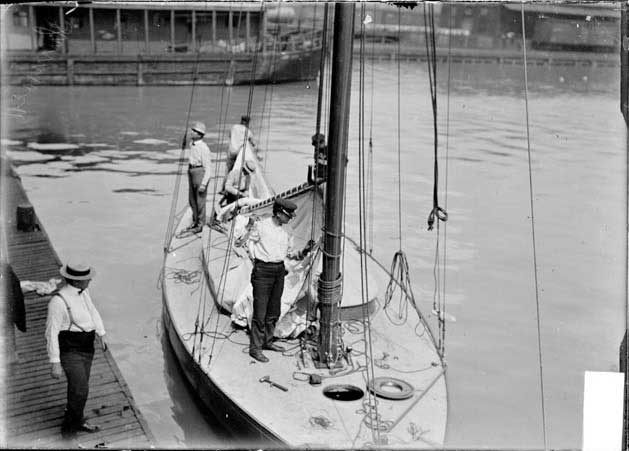 |
In 1927, the Club purchased "Pere Marquette #4", a 193' steamboat, and towed it
to the Randolph Street location. In 1936, this ship was replaced by a former
lake steamer the "Florida". A fire in the 1950s destroyed the original
superstructure of the "Florida" which was replaced by a more modern design. By
1982, the growing membership determined that the "Florida" was too small and the
controversial decision was made to purchase a new clubship.
In 1983 the Club purchased the replacement for the "Florida", the "Abegweit" or
"Abby", a 386 foot, 8,500 gross tons, decommissioned railroad-car ice-breaking
ferry from the Canadian National Railroad. This ship had for many years been the
only way to get from the mainland, in Nova Scotia, to Prince Edward Island. In
April of that year 45 club members joined 15 licensed deck and engineering
officers from the U.S. Merchant Marine Academy (all Chicago Alumni) and 6
Canadian officers (returning from retirement), to make "Abby's" final and
longest voyage, the voyage from Pictou, Nova Scotia to Chicago. Today the "Abegweit"
sits proudly at the top of Chicago's Monroe Harbor; home to an active and
welcoming Columbia Yacht Club and a true jewel on Chicago's beautiful lakefront.
She remains the largest privately owned yacht to ever traverse the St. Lawrence
Seaway.
The Clubship Delivery Voyage
When the Chicago Chapter of the U. S. Merchant Marine Academy Alumni
Association, requested volunteers to bring an almost 400 foot long ship down the
St. Lawrence Seaway, Second Assistant Engineer Jules Traut, now a Columbia Yacht
Club member and Columbia's Chief Engineering Officer, was one of the fifteen
association members who raised their hands. The volunteers were told the ship
had been in mothballs for over a year and if not relocated would go to the scrap
yard, that the two week delivery was planned for the spring of 1983, the pay
would be $1 plus the air fare to Halifax, and that their crew would be
un-licensed yacht club members! Looking back, it turned out to be a very
memorable experience and one that he and the rest of the delivery crew will
always treasure.
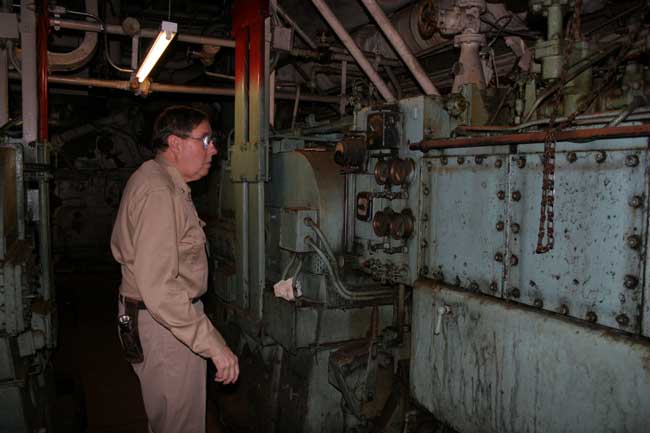 |
"We knew we would have to bring our own tools, radio gear, navigational charts,
etc., as all these types of things had "walked off" the ship while it was out of
service. Imagine going to O'Hare Field today with a tool box full of such
terrorist items as screwdrivers, channel locks, socket wrenches, pry bars, etc.,
along with a one-way ticket out of the country."
"Six of us went up early, on Good Friday morning, thinking we'd use the ship as
our "hotel" and tour Nova Scotia, until the main contingent arrived on Easter
Sunday night. Ha! We arrived at the waterfront in Pictou, Nova Scotia, about 11
pm, in a very cold drizzling rain and fog. Climbing a rickety narrow gangplank,
we entered the vessel at the "mezzanine" level and saw a dim light at the top of
the stairwell. There was one bulb on there, one in what is now the formal dining
room and one in what is now the bar area. Everywhere we walked the dark maroon
floor tile was covered in grit and crunched underfoot. The hull was being
sandblasted and painted (part of the delivery terms) and that grit covered
everything! There was a sheet of paper taped to the bulkhead designating who was
assigned to what cabin. I found mine, dropped my gear on the bunk, found my
flashlight and then went exploring. The rail deck was a wide open "tunnel" from
the stern to almost the bow of the ship with 3 parallel railroad tracks. There
were no lights on and it was very eerie."
"After opening a few hatch type doors, I found a stairwell down to the control
room level and thought I'd entered a Frankenstein movie set. Everywhere I looked
were 1940's vintage knife blade switches, stacks of resistors, large dials and
wheels, etc. I was sure "Igor" would come hobbling out from behind a cabinet at
any moment. There were still no lights as none of the ship's generators were
working. Going down to the main engines level, reality really struck - there
would be no golf, sightseeing or fishing this weekend! Instead a lot of
detective work was in store. I could see and hear multiple dripping noises from
leaking pipes. While examining valve manifolds, I noted that a great number of
brass nameplate disks had been removed and apparently taken as souvenirs. I
returned to my cabin asking myself what the hell I'd gotten myself into!"
"First thing Saturday morning, I went into Pictou, found a local hardware store
and bought all their masking tape and marking pens. Returning to the ship, I got
a couple of the "early birds" together and we started our detective work. There
are 2 separate engine rooms below the rail deck, each containing 8 Dominion
Sulzer 6-cylinder locomotive sized diesel engines paired to 4 main generators.
These created the power to the 4 huge motors driving each of the 4 propellers, 2
forward pulling and 2 aft pushing the ship. We found a sketch in the control
room that designated them by number and put a masking tape label on each. We
then began opening tanks to see if they contained fuel oil, lube oil, fresh or
salt water, bilge or ballast. After labeling the tanks, we traced the piping to
and from them, to pumps or manifolds. Labeling the pumps, we then traced the
conduit from their motors to the relay panels and labeled the relays. On the
circuit breaker panels in the control room, we found that fortunately the
identification cards had not been removed and these confirmed our detective
efforts."
"Next we figured out how to start one of the small emergency diesels in a room
off the rail deck. This provided 440v DC power to the control room and enabled
us to start a saltwater, fresh water, lube oil, fuel oil and vacuum pump for 1
of the 3 ship's generators. Once running, that generator in turn produced power
to start the auxiliary pumps and then the other 2 ship's generators. We then had
enough power to start the comparable support pumps and systems for the main
engines. This was a great example of the "domino effect" but to accomplish it
took all day Saturday, and a good part of Sunday. We also marked all of the
pressure gauge and thermometer dials about mid-range with marking pens, as well
as labeling all the valves. This labeling would prove invaluable once the novice
yacht club crew joined us."
"The main contingent of the crew (the yacht club members and the rest of the
USMMA licensed officers) arrived late Sunday and their "orientation" started on
Monday morning. We didn't have time to get into a lot of technical marine
engineering, so we just simplified the key points of their duties. The entire
crew was divided into 3 watches so everyone worked at least a 4 hours on and 8
hours off shift for the entire trip. My team was the 4 am to 8 am and 4 pm to 8
pm shift. Key training included such things as showing them where a shoe box
sized manifold was on each engine that distributed lube oil from 12 small
plunger type pumps to key lubrication points, Each manifold had a vertical glass
tube in one corner and you could thus see the level of oil in the manifold. They
were told that it was vitally important to always have at least "half a glass"
oil level visible. In similar fashion, they were instructed to grasp both
cooling water pipes on the back of each of 8 main generators each time they
passed by. The one touched by their left hand, "closest to their heart," should
be the warmer than the one in their right hand, which meant that the generator
was getting proper cooling. This was about as technical as things got."
"Over a coffee at the log desk one of the guys on my watch asked me how in the
world I knew how to do all this stuff, especially on a strange ship that I had
never served on. I answered that it was just part of our training at the Marine
Academy, but not having sailed actively as a ship's engineer for 24 years, this
delivery trip showed me just how good that U. S. Merchant Marine Academy
training was. While stopped in a lock when the entire Seaway System was
temporarily in a "stop and maintain position" mode due to very heavy fog, we
lost the entire electrical system and were a "black ship" with absolutely
nothing running. The system had become overloaded when some additional
ventilators were turned on. Anyway thanks to the Marine Academy's training we
were back on line and ready to move about 28 hectic minutes later, after a lot
of flying around in the engine rooms to get everything going again."
"A huge amount of credit and praise is due the Columbia members that made the
trip. They came from all walks of life and everyone rolled up their sleeves and
pitched in to accomplish this voyage. All of us worked a lot harder then we had
anticipated would be necessary and accomplished the impossible. The Seaway
people were very nervous when learning that we had a largely "untrained" crew,
but by the time we had progressed through the first few locks, the "word" was
passed by radio that these people seemed to know what they were doing. We also
had great support from the Canadians who came out of retirement to make the last
voyage of their favorite ship. They helped us decipher some of the systems,
locate spare parts scattered all over the ship, to fix leaks or get broken pumps
fixed, etc."
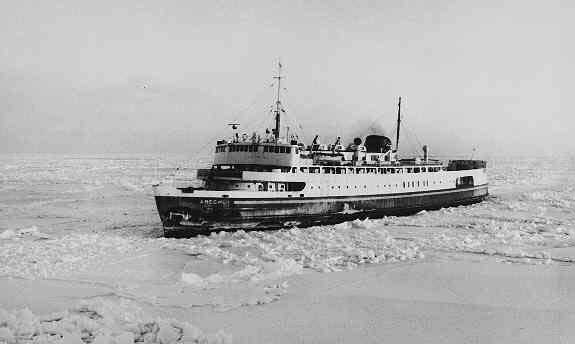 |
"The touching tributes and warm greetings we received at each of the locks and
whenever we passed under a bridge made us soon realize what great service this
ship had offered over the years. Canadians who had been transported to and from
Prince Edward Island by the ship had signs wishing "Abby" a safe voyage, dropped
flowers from the bridges, tooted car horns in salute, etc. The Canadian Coast
Guard also sent out an ice breaker to bid her farewell and circled us while we
were still crunching our way through the ice packs in the Gulf of St. Lawrence."
"It took us 10 days to reach Chicago. While enroute, we continuously broke
through ice reported up to 12 feet thick for about the first third of the
voyage. The "Abby" was one of the largest ice breakers in the world and handled
herself admirably. We found out, as an aside, that the State Department had
gotten involved in the original negotiations for the purchase of the ship for
Columbia because they did not want it to fall into the hands of the Russians
because of her ice breaking capability."
"The weather turned very sour on the final leg of the trip from the Straits of
Mackinac to Chicago. The winds were right out of the north and gusting in excess
of 35 mph. We were taking solid water against the windows on the bridge and
there was sincere concern regarding the following seas we were in. The sister
ship of the "Abby" foundered and sank in a following sea. Take a good look
sometime at the flimsy metal door all the way aft on the rail deck. It is much
like the roller "curtain type doors" you see on some storefronts, i.e., not very
strong. A wave broke over the end of the sister ship, and with the rail deck
only about 6 feet above the waterline, it took the door out. The volume of water
that then cascaded into the rail deck area, created negative buoyancy and the
ship sank!"
"Somewhere off Racine, we almost hit a net trawler that was moving west to east
right across our bow. They ignored our horn and lights (there was some thought
that they were on autopilot and possibly even sleeping) but fortunately for both
parties they missed us by less than 50 yards!"
"Original plans were for us to stop in Kenosha to pick up those club members who
had contributed to the bond issue to purchase the boat but were unable to take 2
weeks off to help bring it here. The idea was that as a reward, they could make
the last 40-50 miles of the voyage. Unfortunately for them Lake Michigan had
other ideas, and the swells rolling into Kenosha harbor were in excess of 12
feet so the pick-up had to be cancelled."
"On arrival in Chicago we pulled into the south side of Navy Pier, sheltered
somewhat from the winds, and then took a short cruise the following day on the
Lake for those we couldn't pick up in Kenosha, before tying her up on the north
side of the present breakwater in what was then a turning basin on the Chicago
River and now of course is Du Sable Harbor."
"I don't know what specific fuel prices were back then, but given the fact that
the "Abby" was being retired due to fuel prices (as she burned 55 metric tons of
fuel a day when all engines were operating) the rumor that it cost the club more
to pay for the delivery trip fuel than it did to pay for the purchase of the
ship itself did not really surprise us."
"Some 4 or 5 years later, the City of Chicago informed us that the club's lease
designated "Monroe Street Harbor" and so we had to move the ship the 40 feet or
so from one side of the breakwater to the other. With the ship no longer running
this was no small feat and it involved (at a cost of over a quarter of a million
dollars) hiring pile drivers to sink mooring stanchions at both ends of the
ship, cutting some 80 feet out of the existing pier/dock, hiring 2 tug boats to
move us and then cutting new entry doors on both sides of the ship so members
could walk through the ship to the pier/dock."
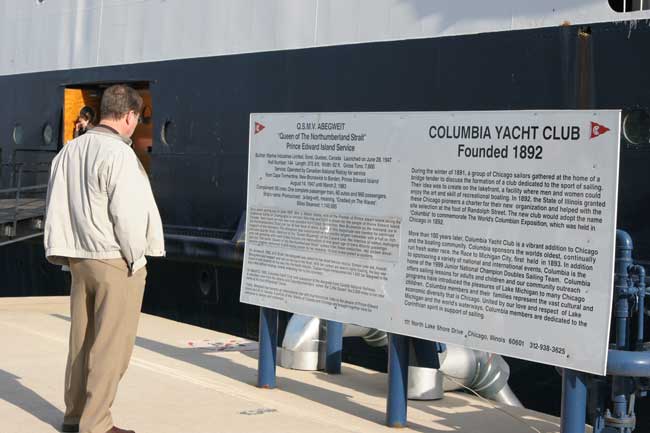 |
The Ongoing Clubship Makeover
The Clubship, as you would expect of a 55 year old vessel is in continual need
of maintenance. In addition, frequent upgrades are required to meet the changing
requirements of the membership. Responsibility for these projects falls upon the
"House Committee" which oversees maintenance with little more than a shoe-string
budget and the kind donations of materials, equipment and sweat equity from club
members.
Members have restored the ship's bridge, the radio room and ship's compass, the
library, dining room and ladies lounge to like new. The bar has been lovingly
re-varnished by members every year and in the last few years they have rebuilt
the kitchen, replaced the original steam heating system, installed A/C in the
bar and dining room, built a grill in the bar and upgraded the water system.
This year aside from the ongoing maintenance and redecoration efforts, a donated
wide-screen HDTV has been installed in the bar and members are working alongside
contractors installing an elevator to provide access to all three decks of the
ship for the older or less mobile club members.
Vice Commodore, Bill Bartz got pulled in to the House Committee when someone
asked him to lend a hand. Ten years and several thousand feet of conduit later
he is 90% complete on his task of upgrading the ship's wiring!
Columbia Yacht Club Today
Sandwiched between Chicago's Monroe and Du Sable Harbors and just south of
Chicago's Navy Pier, the Clubship and it's dock provide it's members and their
guests unquestionably the ultimate platform for watching the Independence Day
and Venetian Night fireworks spectaculars, and if that is not enough we also get
our "private" bi-weekly (Wednesday and Saturday) fireworks shows all summer long
courtesy of Navy Pier!!
Membership Events
Socially the club has a broad and diverse membership, both in terms of age and
interests. Young or old, flip-flops or formal, Columbia's Activities Committee
makes sure that in addition to the expected on the water activities, shore-side
there is something to offer everyone.
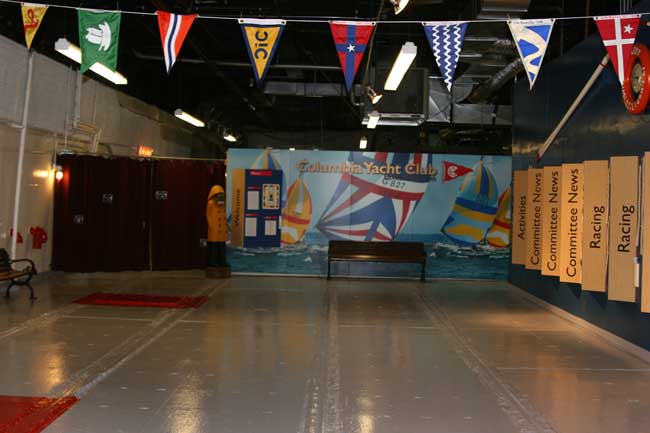 |
For the kids highlights of the year include Easter with bunnies, eggs and
treasure hunts, summer kite flying, and an incredible Kids Halloween party (with
the club turning itself into an authentic Ghost Ship, complete with ghouls,
witches, cauldrons, fortune tellers and mummies). The huge Children's Holiday
party is the finale to the year, when a long-standing member with "an inside
track" to Santa, gives the kids the opportunity to whisper their desires into
Santa's ear and get a Christmas photo with him.
For the grownups the jam-packed social activities schedule provides the adult
membership with events from Black Beard to Black Tie and Tie-Dye!!
The Black Beard event is in conjunction with the national Talk Like a Pirate
Day. Columbia hosts a "Pirate's Ball" in September, which "brings out the pirate
in" hundreds of our members and their guests, with the best-dressed pirates
making off with all the booty from Columbia's very own swashbuckling event.
Black Tie gives everyone the chance to dress up at the stunning Commodore's
Reception, Holiday Dinner Dance and New Year's Parties.
Tie-Dye, another event that is Columbia's own is the "Dead Of Summer Party" with
a number of our most active members selling "original" Columbia Tie-Dye
creations (hats, shirts and skirts) to the revelers, who dance and party the
warm mid-summer night away on the dock to the sounds of one of our favorite
Grateful Dead tribute bands while taking their fill of our chefs pig-roast.
Columbia's Sailing School
Providing sailing instruction for both adults and kids, the sailing school lets
you leave life as a landlubber behind. Many club members have come to the school
for lessons and then joined the club to fully participate in the ongoing sailing
camaraderie.
Our Adult Sailing Program offers hands-on experience in the classroom and on the
water. You choose the vessel: 420 dinghies or J-22 sloop-rigged keelboats. This
is supplemented by our Skipjacks Program which is a member-sponsored
learn-to-sail program for adults run on Tuesday evenings using those club
members' boats. Building on that experience some students choose to become
involved with the Wednesday night Beer Can racing while others elect more
private or group lessons. Racing Clinics are designed to teach advanced boat
handling maneuvers and sail trim techniques to give you an edge on the race
course and our US Sailing Keelboat Certification Program enables you to become
certified to charter a boat with confidence, both locally and abroad in just two
short weekends.
During the summer, as many of the adult members toil in their offices, hundreds
of junior sailors stream through the Columbia doors and take over the dock. The
Junior Sailing Program offers these students (from 8 to 18) the opportunity to
take the helm and get a head start on a lifetime of sport. Spring, Summer and
Fall sessions in Optimists, 420s and Lasers ensure a wide variety of challenges
to young sailors of all skill levels. This is our next generation learning to
harness the wind for their enjoyment. Those who qualify for the 15 - 20 member
racing team will travel to neighboring states or as far as the East and West
Coasts to compete in various regattas during the summer. The Opti race team,
composed of six of our younger sailors, has traveled about five thousand miles
to compete against others in the under ten-year old division.
Many recent graduates of the Columbia Junior Sailing Program have qualified for
college sailing scholarships and currently there are two girls and two boys
sailing on three different boats attempting to qualify for the US Olympic Team.
Finally Columbia is also home to the Sea Scout Ship "Challenge" #5111. The Sea
Scout program teaches young adults (13 to 18 years old) not only to sail but the
basics of good citizenship and leadership through sailing, stressing both safety
and sportsmanship.
Boating at Columbia - Spring, Summer and Fall
During the summer, life revolves around boats and the Lake, as one might expect,
with a variety of on the water activities to engage every type of boater.
Our Power Fleet offers a Leukemia Cup "Poker Run", raising money for the
Leukemia & Lymphoma Society running between every harbor on the Chicago
lakefront collecting playing cards and returning to the Columbia dock to see who
has collected the best poker hand for the grand prize, and of course, a rocking
party. Chicago's Venetian Night also provides the Power Fleet the opportunity to
join with their Sailing Fleet brethren and dress their boats up for a
spectacular harbor parade and fireworks display which challenges the
Independence Day fireworks for the best show of the summer.
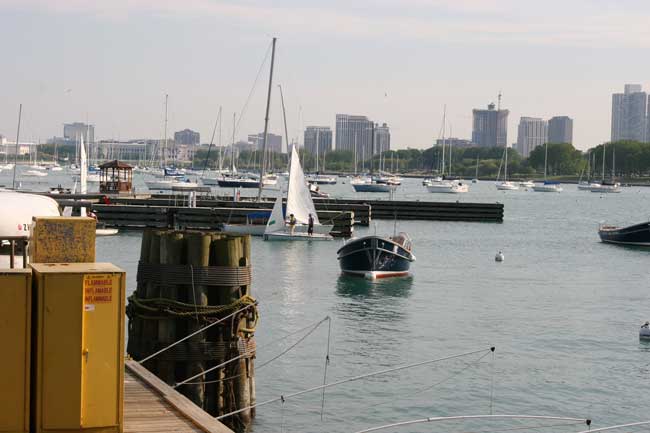 |
Sail Fleet members have their choice of cruising Lake Michigan with the Cruising
Fleet or a wide range of racing options ranging from the casual Beer Can racing,
to the more competitive LMSRF Area III and MORF racing, the huge West Marine One
Design, Lands'End NOOD, Leukemia Cup and Verve Cup regattas as well as of course
the Chicago MAC race. Racing and cruising fleets are not mutually exclusive as
we frequently see racers join in on a cruise, and equally members of the
"cruising fleet" are regular entrants in the Wednesday night Beer Can Races.
The cruising events range from long weekends to Michigan City and Hammond to
"cruising the harbor" from boat to boat for a potluck dinner or cruising to
another club for lunch. It is a congenial group which always welcomes new
members and encourages non-boat owners to join in.
Columbia has made a strong commitment to Chicago's racing fleet as a regular
sponsor of a number of the LMSRF Area 3 races as well as the growing West Marine
One Design regatta, providing race committee and hosting post-race parties on
the our dock after every race they host. Among the races we sponsor is the
world's oldest continually run freshwater race, the Chicago to Michigan City
race (which is older than even the Chicago MAC race). In addition there is our
Commodore's Invitational (the first race of the season), the Mayor Daley and
Centennial Regatta, the Fran Byrne, and the overnight first leg of the Tri State
Race, the Chicago to St. Joseph in Michigan.
Columbia also hosts Chicago's Wednesday and Friday night Beer Can racing which
draws a more casual crowd from all Chicago's clubs in the Monroe harbor area.
Beer Can racing in Chicago is almost as big as the LMSRF Area III racing and it
is not uncommon to see over 100 boats going off the line in classes that range
from Jib and Main (JAM) to spinnaker sections with the Santa Cruz 70s.
Columbia's racers are consistently at the top of their classes. For 6 of the
last 8 years Columbia boats have won the LMSRF Area III "Overall PHRF Boat of
the Year" award with "Assassin" having just won it back-to-back in 2004 and
2005, and this year adding to our club laurels further, "Kutty's Ark", one of
the club's oldest boats, won the Mackinac Trophy in it's 30th MAC race!!
Finally wrapping up our on the water activity and not to be ignored are our
Laser, Vanguard and Penguin racers, a hardy group who besides racing their
summer series can also be seen "frostbiting" in the harbor in the spring and
fall, when the rest of us are snug inside.
Entertainment and Fine Dining at Columbia
With its breathtaking views of the city and lakefront Columbia Yacht Club offers
a fine dining and special event venue unmatched in the city. Columbia's
ever-changing menu highlights the bold, the new and the delicious. Our chef and
his staff use the freshest produce and finest meats and seafood available,
indeed those familiar with Allen Brothers Steaks or the impeccable seafood from
Wabash or Plitt Seafoods will not be disappointed, as these are the club's
primary meat and seafood suppliers. A combination of seasonal specialties and
proven favorites, along with a stellar view of Lake Michigan and the skyline,
make dining at Columbia an experience certain to please even the most discerning
palate.
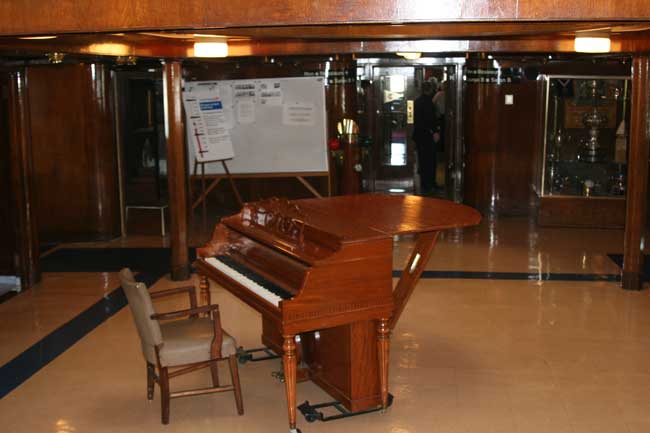 |
Although primarily servicing its members the Clubship is available for special
event rental for parties large or small. Its various decks, salons and even the
ship's beautifully restored bridge provide a wide and spectacular range of
settings in which the club's professional staff can cater for a gala wedding for
410 or a business meeting for 10.
An Open and "Floating" Invitation
Entering or even seeing Columbia Yacht Club for the first time sitting in her
prime berth on Chicago's waterfront, one immediately is struck by how unique
this place really is. A yacht club on a boat is not an ordinary venue. Looking
around the Clubship however, one still sees members working on various
maintenance and upgrade projects, continuing the tradition of our founding
members who built the original club structure by hand more than 100 years ago.
Columbia Yacht Club is a place where individuals of many ages and backgrounds,
members, guests and visitors, join to share their love of the water. The
Clubship, "Abegweit", is home to a vibrant community of sailors and power
boaters committed to sportsmanship and fun.
Columbia already offers reciprocal visiting yachtsman privileges with many yacht
clubs but to visit the Clubship or learn more about lessons, membership, hosting
an event or any of the activities mentioned, please call 312-WET-DOCK
(312-938-3625) and someone will be happy to help you.
For more info on the Columbia Yacht Club visit www.columbiayachtclub.com.